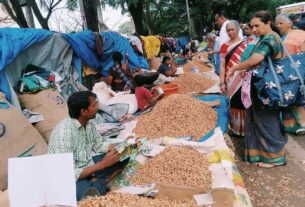Street food vendors continue to use newspapers as food packaging material in the absence of awareness and affordable alternatives.
Street food vendors and local shops in the city continue to serve and pack food in newspapers despite the Food Safety and Standards Authority of India’s (FSSAI) directive against it. This raises health concerns, as the printing inks used contain harmful colours, binders, additives, and preservatives, and used newspapers can harbour potentially harmful pathogens, posing serious health risks to consumers.
Abdul, the owner of a food shop in Shivaji Nagar, where newspapers are regularly used to serve food, said that he was unaware of the FSSAI directive. However, he said that he is aware of the potential health risks associated with using newspapers to absorb excess oil from fried food or using it as a plate.“Tissues and napkins are not affordable alternatives to newspapers due to their high price, so we do not have any other option but to continue using newspapers to serve food,” he said.
Murali, a street food vendor, also expressed his reluctance to switch to alternative options due to the economic impracticality. “One kilogram of newspaper costs Rs. 15 to Rs. 20, unlike costlier alternatives such as tissues or paper plates. Additionally, a single newspaper can be used to serve multiple customers, which is not the case with paper plates or tissues,” he said.
Though a majority of the shopkeepers remain uninformed about the directive, some have adopted safer and more sustainable food packaging methods in response to customer demand. Ganesh, a cut fruits seller, said that he started using leaf plates to serve fruits after noticing customers hesitating to buy food served in newspapers. “Even if the alternatives are not feasible, there is no point in sticking to the old ways. When your business is declining, you must adapt,” he said.

Shwetha, a college student, said that she has observed samosas, chaats, and muri mixture being served in newspapers in the city. “Some shops even substitute newspapers for napkins or tissues to wipe hands after eating,” she said. She is aware that the newspapers might not be stored in hygienic conditions and that the chemicals from the print can have adverse health effects, she said. But the irresistible taste of the food often tempts her to consume it, even if it is served in newspapers. “Taste often outweighs health concerns,” she said.
Madhusudhan, an auto driver, said that he was not aware of the health risks linked to food served in newspapers. “But even if I knew, I do not have any other option but to depend on such food during breaks between rides because of its affordability and taste,” he said.
Mohan, a working professional, said that though most shops have adopted the use of paper plates for serving food, there are still a few that continue to use newspapers for absorbing excess oil from fried food or as a serving medium. “It is not possible to entirely avoid eating at such places,” he said.
Sharing his experience, he said that earlier in his household as well, they used newspapers to soak extra oil from fried food. However, as awareness grew regarding its adverse effects, they shifted to using tissue paper even at home. “We chose to prioritise health over convenience,” he said.

Mohammed Javeed, President of the All India Street Vendors Public and Charitable Trust said that a majority of the street vendors are unaware of the FSSAI directive and the potential health risks associated with using newspapers to serve food. Even if they know, complying with this directive is a challenge for small-scale street food vendors due to financial constraints, he said. “They cannot afford pricier alternatives like foil papers, tissues, or brown papers when newspapers are both cheap and readily available,” he said.
However, Suchitha, Programme Coordinator at FSSAI, Karnataka, said that awareness programmes aimed at educating both food business operators (FBOs) and the general public on food safety are being carried out to address this issue. “We also create awareness among the food vendors on the health issues posed by the use of newspaper as a food packaging material and suggest potential alternatives during our quality inspections,” she added.
The directive was issued in 2016 to mitigate the health risks associated with the presence of chemicals and pathogens in used newspapers, which can impact food safety when used as food packaging material, she said. “Though the directive was implemented in 2016, no fines have been levied so far on food vendors using newspapers for packaging, primarily because most of them are small-scale vendors. And these vendors not being registered under the FSSAI further complicates the enforcement,” she added.
Parchment papers, paper plates, or leaf plates can be used as alternatives to newspapers for food packaging, she said. “Even plain white paper can be used for serving food, as the ink content in the paper is the primary source of health-related issues, not the paper itself,” she said. Consumers should also be more vigilant about the safety of the food they consume and not compromise their health for the sake of taste, she added.
Javeed highlighted the importance of government and corporate involvement in alleviating the issue of the unavailability of affordable alternatives to newspapers for food vendors. “Government initiatives and corporate social responsibility (CSR) activities such as providing financial support to organisations and trusts aimed at supplying affordable food packaging alternatives to street vendors, could make a positive impact in this regard,” he said.

Experts say that chemicals found in printing ink and the presence of pathogens in used newspapers can potentially lead to health issues when used as food packaging material.
Dr. Jyoti Vijay, Assistant Professor at the Indian Institute of Health Management Research, Bangalore (IIHMR), said that newspaper ink contains bioactive substances that can potentially migrate into food when used as packaging material. “This can introduce chemicals like sulphides, ethanol, pigments, and lead into the food, which, when consumed, may contribute to various health problems, including liver, kidney, and heart ailments. It can even lead to digestive issues and increase the risk of cancer,” she said. The handling of newspapers and their storage in unhygienic conditions can also introduce harmful pathogens into the food, posing a significant threat to human health, she added.
“It’s essential to explore alternatives to newspapers for food packaging that not only prioritises food safety but also support a sustainable environment,” she said. Materials such as bamboo, sugarcane, and cornstarch offer safer and biodegradable packaging options, she said. Vendors can also consider using stainless steel utensils for serving food, which may require a one-time investment, she added.
Authorities should take initiatives to raise awareness among vendors about the health implications associated with using newspapers for food packaging and provide training on adopting safer alternatives, she said. “These measures must be implemented in a manner that is affordable and doesn’t impose an undue financial burden on the vendors,” she added.




